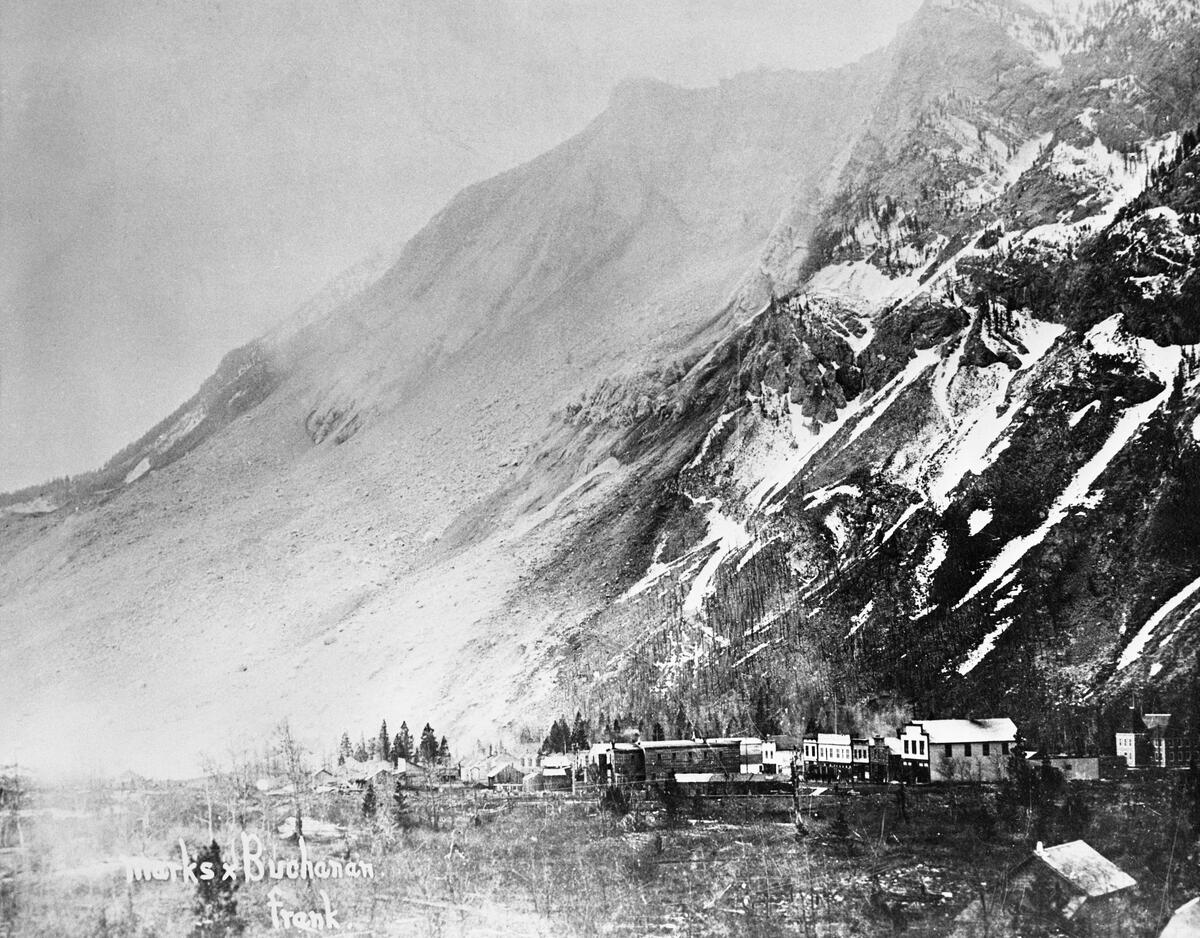Current Temperature
-13.1°C

The Frank Slide: Learn About – and Visit – Canada’s Deadliest Rockslide
Posted on May 22, 2025 by Nerissa McNaughtonThe Frank Slide remains one of the most sobering and fascinating chapters in Canadian history. This rockslide reshaped the physical landscape of Turtle Mountain and the town of Frank while also carving a place in history as a powerful illustration of nature’s force and the resilience of the human spirit. Let’s dig in and learn more about the Frank Slide, how it occurred, and why it continues to be a site of respectful contemplation for visitors and scientists alike.
What is the Frank Slide?
On April 29, 1903, at 4:10 a.m., a devastating rockslide tore through the eastern side of Turtle Mountain, pouring down on the coal-mining town of Frank. Within just two minutes, 110 million tonnes of limestone buried a massive three-square-kilometer area. Homes, businesses, and lives were lost under debris piled as deep as 45 meters in places. This tragic event claimed the lives of over 70 people, though the actual number remains uncertain, as many bodies were never recovered.
Today, the Frank Slide remains Canada’s deadliest landslide, a grim but fascinating reminder of the relationship between nature’s power and human tenacity. Its scarred terrain serves as both a geological site and a memorial for those who perished.
How Did It Happen?
The Frank Slide was not a random event but the result of a complex combination of environmental and human factors. Turtle Mountain, known as “the mountain that moves” by Indigenous Peoples, had been geologically unstable for millennia. Here’s what contributed to its fatal collapse:
- Geological Instability: The mountain’s structure consisted of fractured limestone sitting precariously over softer shale and sandstone. Several deep cracks and fissures ran along its surface, making it prone to movement.
- Coal Mining Activities: Mining operations in Frank began in 1901. Removing coal from the mountain base likely weakened its structure, making it more fragile.
- Environmental Conditions: Weeks of heavy precipitation and sudden freeze-thaw cycles in the spring of 1903 likely widened the fissures. Seismic activity from coal mine blasting might have further destabilized the mountain.
This convergence of natural geology and human activity led to the catastrophic collapse of Turtle Mountain’s eastern slope.

Are There Bodies Still Under the Rubble?
Despite recovery efforts after the disaster, most of the victims of the Frank Slide were never found. Less than 20 bodies were recovered from the site, meaning that dozens of individuals likely remain buried beneath the rubble to this day. The sheer depth of the rock and the magnitude of destruction made efforts to retrieve the rest unfeasible, and the site has since become a burial ground.
What Have We Learned?
The Frank Slide has taught scientists and geologists countless lessons about the relationship between geological stability and human activity. It was one of the first major events to prompt ongoing geological monitoring and research.
Today, Turtle Mountain is continually observed, with equipment installed to measure fissure growth and track rock movements. This monitoring aims to predict potential landslides in the area, minimizing risks to local residents and infrastructure. Scientists also now recognize the importance of respecting natural warning signs, such as instability in mountain structures.
Additionally, the disaster has underscored the need to balance industrial pursuits like mining with environmental considerations and safety protocols. The Frank Slide presents a good case study for researchers looking to prevent similar tragedies worldwide.
Importance of the Site
The Frank Slide is more than just an historical event; it’s a cultural and scientific landmark. It tells a story of resilience in the face of disaster. After the slide, the town of Frank persevered, reopening its coal mine just weeks later and quickly rebuilding. The legacy of the slide and the community’s response speaks to the indomitable human spirit.
Designated as a provincial historical landmark, the site is an invaluable educational resource. It serves as a platform for understanding geological processes, the history of western Canada’s coal industry, and the impact of environmental disasters on communities.
How and Why to Visit
Visiting the Frank Slide is both an educational and emotional experience. The Frank Slide Interpretive Centre, located in Crowsnest Pass, offers an opportunity to learn about the disaster.
The centre features detailed models, firsthand accounts, and geological information about how and why the slide occurred. Documentaries recount the events of that day, and what followed. Spend a few quiet minutes looking out over the scene of the disaster, remembering that life can change forever in just a few moments – and that rebuilding is possible.
Why visit? Beyond the history, the site invites reflection on the fragility of life and the awe-inspiring power of nature. It’s a unique opportunity to stand in the shadow of a mountain with a story to tell.
Plan Your Trip
The Frank Slide Interpretive Centre is open year-round, with seasonal hours and affordable admission rates for families, adults, and seniors. Located just 1.5 kilometers off Highway #3 in Alberta, it’s easily accessible. To learn more or start planning your visit, check out the Frank Slide Interpretive Centre website.
Nerissa McNaughton is a freelance writer and a contributor to Alberta Newspaper Group. This story was written for the Alberta Newspaper Groups Summer Escapes Guide advertising feature. Summer Escapes is a special feature about things to do in Alberta this summer. Activities like, staycations, road trips, camping, and other adventures including local attractions, events and food & beverage destinations across Alberta. It is not written by and does not necessarily reflect the views of the editorial staff.
Leave a Reply
You must be logged in to post a comment.



